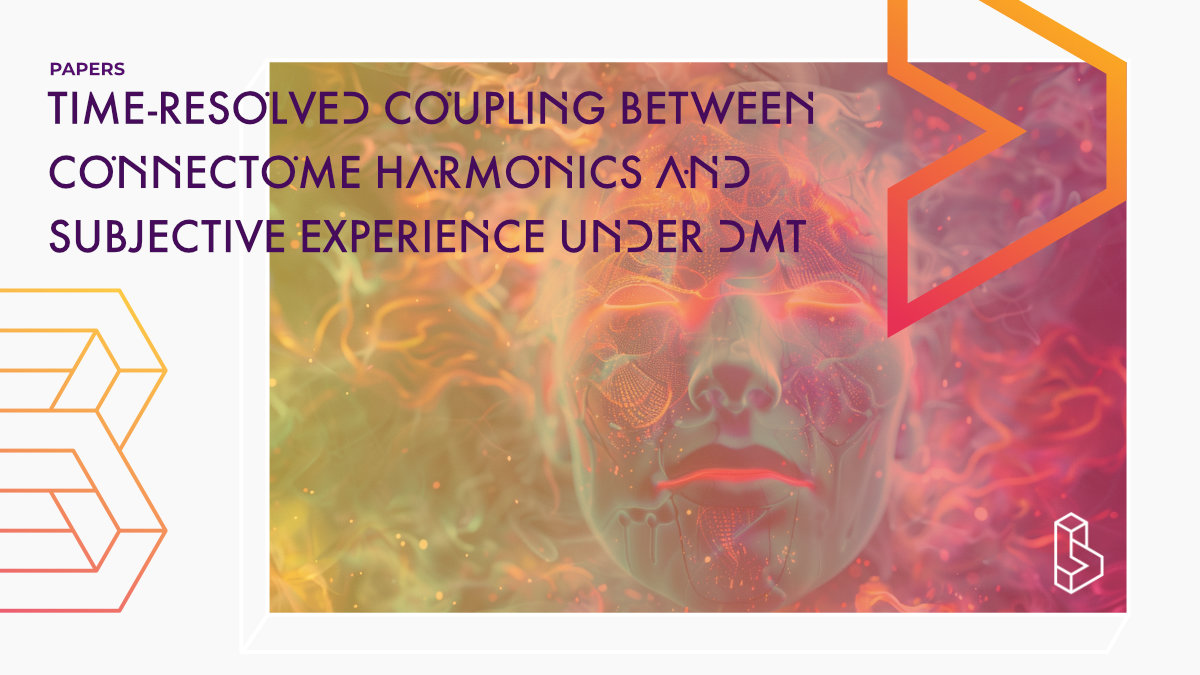This reanalysis of a single-blind neuroscience study (n=17) explores the relationship between brain structure and function, focusing on subjective experience through the use of psychedelic substances. It uses connectome harmonic decomposition to demonstrate that the connectome harmonic repertoire and entropy increase under DMT, and these measures correlate with the intensity of subjective experience, similar to effects seen with psilocybin, LSD, and ketamine.
Abstract of Time-resolved coupling between connectome harmonics and subjective experience under the psychedelic DMT
“Exploring the intricate relationship between brain’s structure and function, and how this affects subjective experience is a fundamental pursuit in neuroscience. Psychedelic substances offer a unique insight into the influences of specific neurotransmitter systems on perception, cognition and consciousness. Specifically, their impact on brain function propagates across the structural connectome — a network of white matter pathways linking different regions. To comprehensively grasp the effects of psychedelic compounds on brain function, we used a theoretically rigorous framework known as connectome harmonic decomposition. This framework provides a robust method to characterize how brain function intricately depends on the organized network structure of the human connectome. We show that the connectome harmonic repertoire under DMT is reshaped in line with other reported psychedelic compounds – psilocybin, LSD and ketamine. Furthermore, we show that the repertoire entropy of connectome harmonics increases under DMT, as with those other psychedelics. Importantly, we demonstrate for the first time that measures of energy spectrum difference and repertoire entropy of connectome harmonics indexes the intensity of subjective experience of the participants in a time-resolved manner reflecting close coupling between connectome harmonics and subjective experience.”
Authors: Jakub Vohryzek, Andrea I. Luppi, Selen Atasoy, Gustavo Deco, Robin L. Carhart-Harris, Christopher Timmermann & Morten L. Kringelbach
Summary of Time-resolved coupling between connectome harmonics and subjective experience under the psychedelic DMT
Understanding how brain structure and function interact to shape subjective experience is a central question in neuroscience. Psychedelic substances offer a powerful window to interrogate how specific neurotransmitter systems shape brain function. A mathematical framework called connectome harmonic decomposition (CHD) is used to characterise how brain function depends on the underlying network organisation of the human connectome. CHD transforms brain signals from the spatial domain into the domain of connectome frequencies. Recent work has consistently demonstrated that psychedelics affect the connectome harmonic landscape of the human brain in two prominent ways: (1) they reduce the contribution of low-frequency (large-scale) harmonics to spontaneous brain activity, and (2) they increase the diversity of the repertoire of connectome harmonics. Intravenous DMT has a fast onset and reliably short duration of approximately 8 minutes, which makes it possible to obtain dynamic ratings of the intensity of subjective experience over time, and then relate these data to the corresponding time-resolved changes in connectome harmonics.
We recruited 25 participants in a single-blind, placebo-controlled and counter-balanced design, and scanned them on two days, two weeks apart, each consisting of two scanning sessions. The first session lasted 28 minutes and the second session was identical to the first except for the assessment of subjective intensity scores. fMRI was performed on a 3T scanner with compatibility for EEG recording using a T2 -weighted echo planar sequence and 35 slices with 0 mm interslice distance. FMRI pre-processing included despiking, slice-timing correction, motion correction, brain extraction, rigid body registration to structural scans, non-linear registration to 2mm MNI brain, motion-correction scrubbing, spatial-smoothing, band-pass filtering, and regression of 9 nuisance regressors. Nine participants were considered for this analysis following rigorous exclusion criteria, including age, history of psychiatric disorders, and cardiovascular disease.
Find this paper
https://doi.org/10.1101/2024.05.30.596410
Open Access | Google Scholar | Backup | 🕊
Cite this paper (APA)
Vohryzek, J., Luppi, A., Atasoy, S., Deco, G., Timmermann, C., Carhart-Harris, R. L., & Kringelbach, M. L. (2024). Time-resolved coupling between connectome harmonics and subjective experience under the psychedelic DMT. bioRxiv, 2024-05.
Study details
Compounds studied
DMT
Topics studied
Healthy Subjects
Neuroscience
Study characteristics
Original Re-analysis
Placebo-Controlled
Single-Blind
Within-Subject
Randomized
Re-analysis
Participants
17
Humans
Compound Details
The psychedelics given at which dose and how many times
DMT 7 - 14mg | 1x
Linked Research Papers
Notable research papers that build on or are influenced by this paper
Time-resolved neural and experience dynamics of medium- and high-dose DMTThis repeated-measures dose-dependent study (n=19) investigates DMT's subjective and neural dynamics under naturalistic conditions. Participants received 20mg or 40mg doses of freebase DMT in a blinded, counterbalanced design, with EEG data and time-resolved subjective measures collected. The 40mg dose produced more intense visual hallucinations and emotional responses. Neural analyses revealed alpha power and permutation entropy were most associated with subjective experiences, whereas lempel-ziv complexity was less predictive, challenging prior assumptions about its role in psychedelic states.
Neural correlates of the DMT experience assessed via multivariate EEG
This placebo-controlled EEG study (n=13) found that DMT reduces (oscillatory power) activity in the alpha and beta bands and increases them (especially at the peak) in the delta and theta bands.

